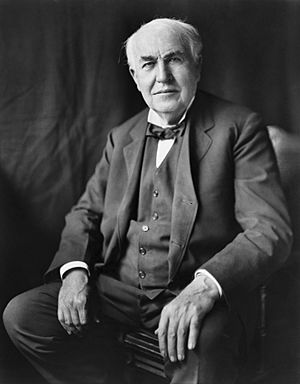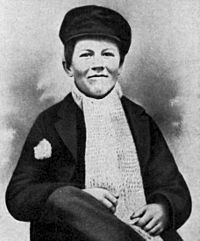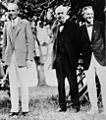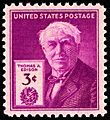Thomas Edison facts for kids
Quick facts for kids
Thomas Alva Edison
|
|
|---|---|

"Genius is one percent inspiration, ninety-nine percent perspiration."
– Thomas Alva Edison, Harper's Monthly (September 1932) |
|
| Born | February 11, 1847 |
| Died | October 18, 1931 (aged 84) West Orange, New Jersey, United States
|
| Cause of death | Diabetes |
| Occupation | Inventor, scientist, businessman |
| Spouse(s) |
Mary Stilwell
(m. 1871–1884)Mina Edison
(m. 1886–1931) |
| Children | Marion Estelle Edison (1873–1965) Thomas Alva Edison Jr. (1876–1935) William Leslie Edison (1878–1937) Madeleine Edison (1888–1979) Charles Edison (1890–1969) Theodore Miller Edison (1898–1992) |
| Parent(s) | Samuel Ogden Edison, Jr. (1804–1896) Nancy Matthews Elliott (1810–1871) |
| Relatives | Lewis Miller (father-in-law) |
Thomas Edison (February 11, 1847 – October 18, 1931) was an American inventor and entrepreneur who invented many things. Edison developed one of the first practical light bulbs, but contrary to popular belief, did not invent the light bulb. Edison's received 1093 patents, which was the most granted to any inventor in his time. He started the General Electric Company to make some of the things he invented. He died due to a disease called diabetes.
Contents
Early life
Thomas Alva Edison was born in Milan, Ohio. When Edison was seven years old, he moved with his family to Port Huron, Michigan, where he started school late because of an illness. Three months later, Edison was removed from school because he could not pay attention to his teacher. His mother, who had been a teacher in Canada, taught Edison at home. Edison's mother helped him become motivated for learning.
When Edison was twelve years old, he caught scarlet fever. The effects of the fever left Edison completely deaf in his left ear and 80 percent deaf in the other. When he was thirteen, he began a job selling candy, newspapers, and vegetables on a train. He used the money he made to buy equipment for chemical and electrical experiments.
After Edison saved a young boy from being hit by a runaway train, the boy's father trained him to be a telegraph operator ("brass pounder") on the Grand Trunk Railway. At age sixteen, Edison made his first invention, which was called an "automatic repeater." It used punched tape to send telegraph signals more quickly between telegraph stations that did not have operators in them.
Career
In 1868, Edison moved East and began to work for the Western Union Company in Boston, Massachusetts, as a telegraph operator. He worked twelve hours a day, six days a week. Within six months, he had applied for and received his first patent for an electric vote recorder. It made the voting process faster, but he could not find buyers. Then, Edison moved to New York and began to work for a company fixing their machines. At night, he continued to work on his projects.
Menlo Park
In 1876, Edison used the money from his inventions to start his own laboratory in Menlo Park, New Jersey. In just over a decade, Edison's Menlo Park laboratory had expanded to cover two city blocks.
- In 1877~78, he invented the carbon microphone, which made the sound for Alexander Graham Bell's new telephone invention louder.
- In 1877, Edison invented the phonograph, the first machine that could record and play sound. The phonograph made him famous around the world. However, it was later discovered that the French inventor Édouard-Léon Scott de Martinville had invented sound recording before Edison.
- In 1879, Edison made a light bulb that lasted longer than the current light bulbs.
- Another invention in 1879, the electric power distribution network, helped bring electricity to homes and businesses.
West Orange and Fort Myers
After the death of his first wife, Mary, Edison purchased "Glenmont," a home in West Orange, New Jersey, as a wedding gift for his second wife, Mina. The couple spent the winters at a home they purchased in Fort Myers, Florida. Edison kept working no matter where he lived. His main focus while he lived in Fort Myers was rubber. He and his friends Henry Ford and Harvey Firestone started a laboratory where Edison could grow plants that would make rubber so that America would not have to depend on other countries for it.
During World War I, he suggested forming a science and industry committee to provide advice and research to the US military, and he headed the Naval Consulting Board in 1915.
Personal life and children
Thomas Edison married Mary Stilwell in 1871. He had three children in that marriage: Marion Estelle Edison (also called "Dot"), Thomas Alva Edison, Jr. (also called "Dash"), and William Leslie Edison. Mary Stilwell died in 1884 at the age of twenty-nine.
When he was thirty-nine, Edison married his second wife, Mina Miller, who was nineteen. He had 3 children in that marriage: Madeleine Edison, Charles Edison (who took over the company when his father died and was later elected Governor of New Jersey), and Theodore Miller Edison.
Final years and death
Edison was active in business even in his last years. He worked on developing the Lackawanna Railroad and was there when it began. He drove the train its first mile.
Thomas Alva Edison passed away on October 18, 1931, from complications from diabetes. He is buried behind his "Glenmont" home.
Thomas Edison quotes
- "Opportunity is missed by most people because it is dressed in overalls and looks like work."
- "A genius is often merely a talented person who has done all of his or her homework."
- "If we all did the things we are really capable of doing, we would literally astound ourselves."
- "I have more respect for the fellow with a single idea who gets there than for the fellow with a thousand ideas who does nothing."
- "The world owes nothing to any man, but every man owes something to the world."
Interesting facts about Thomas Edison
- Thomas's father, Samuel Ogden Edison, Jr., took part in a protest of the British Crown’s rule of its North American territory. After the protest, he fled to America, where Thomas was born.
- Edison thought his poor hearing helped him concentrate.
- Edison was called "Al" as a child.
- When Thomas was fifteen, he began printing a newspaper on the Grand Trunk Railway called the Grand Trunk Herald.
- Edison's first two children were nicknamed with telegraph-inspired names: "Dot" and "Dash."
- Nikola Tesla worked for Thomas Edison for a short time.
- Thomas has been called "The Wizard of Menlo Park."
- On December 31, 1879, the Menlo Park laboratory was electrically lit for the first time.
- Edison enjoyed reading and reciting poetry.
- Edison made a device to kill cockroaches with electricity.
- The Henry Ford Museum claims to hold Thomas Edison's last breath in a test tube.
Images for kids
-
Photograph of Edison with his phonograph (2nd model), taken in Mathew Brady's Washington, DC studio in April 1878
-
Edison's Menlo Park Laboratory, reconstructed at Greenfield Village at Henry Ford Museum in Dearborn, Michigan. Note: the pipe organ against the back wall.
-
From Left to Right: Henry Ford, Thomas Edison, and Harvey Firestone, the three partners of the Edison Botanic Research Corporation
-
Henry Ford, Thomas Edison, and Harvey Firestone, respectively. Ft. Myers, Florida, February 11, 1929
-
Portrait of Edison by Abraham Archibald Anderson (1890), National Portrait Gallery
See also
 In Spanish: Thomas Alva Edison para niños
In Spanish: Thomas Alva Edison para niños

















